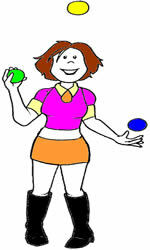There are games and toys that we know today for passing from generation to generation. They have different origins and participated in various stages of the country's development. Today, these games are part of the culture of our people and part of Brazilian folklore that mark the periods lived here.

The Indians who lived in Brazil before its discovery period used a leaf bundle filled with stones that were tied to an ear of corn. They played at throwing this bundle from one side to another, they called it Pe’teka, which in Tupi means to beat.

Of French origin, the hopscotch arrived in Brazil and quickly became popular. The game consists of a design formed by blocks numbered from 1 to 9, with semicircles at the ends that are played with a pebble that must obey the walls of each block.

About 1000 years before Christ, the kite was used as a form of signaling, but when it arrived in Brazil, brought by the Portuguese, the kite became just a form of entertainment. It flies through the force of the winds and is controlled by a rope that allows the rider to make it higher and lower.
Do not stop now... There's more after the advertising ;)

The ciranda, which is the most famous dance in Brazil, was brought from Portugal as an adult dance, but it soon underwent changes and began to bring joy to children's games. It is still widely used today in schools, parks and spaces that value old games, passing them on to new generations, showing its folklore and cultural importance.

The bone game of prehistoric origin is also often passed on to grandchildren by their grandparents. It consists of throwing an object into the air and taking another in its place, doing a juggling game.
By Gabriela Cabral
Would you like to reference this text in a school or academic work? Look:
DANTAS, Gabriela Cabral da Silva. "Fun and Cultural Toys"; Brazil School. Available in: https://brasilescola.uol.com.br/cultura/brincadeiras-brinquedos-culturais.htm. Accessed on June 27, 2021.

